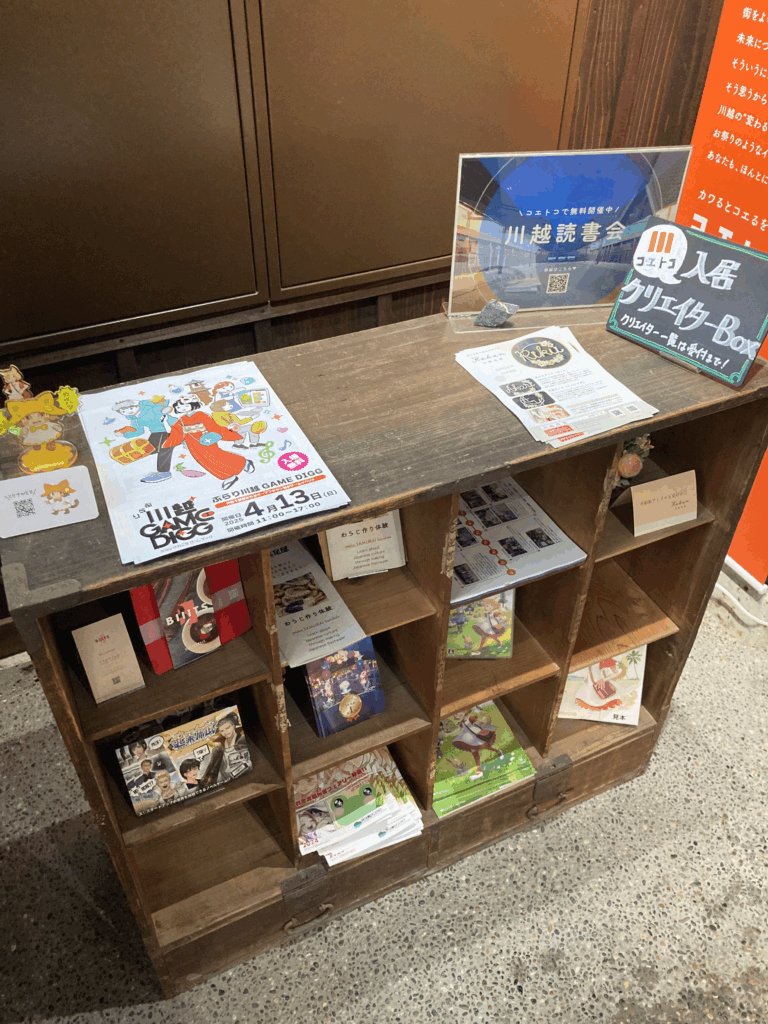
Hello, I’m Mob. I belong to the Negolove team at SKOOTAGAMES. This is the second part of the Kawagoe GAME DIGG report delivered in the rain.
In the first part, we introduced two works that stood out even in the rain: ‘Yuzuri Ninja’, which contained the passionate feelings of the local community in a bowl of udon, and ‘MeloMisterio -play your melody-‘, which provided an unforgettable auditory experience where players themselves played melodies in a special space called “Koetoko.” Both left a deep aftertaste that cannot be fully expressed by simply saying the game systems are interesting.
Now, in this second part, we will focus on two works that left a deeper impression related to more personal feelings and memories, or the essence of play. These experiences felt like touching the gentle gaze of the creators through the screen, or vividly reminding us of the original scenery of “gathering together to play,” which we had completely forgotten.
One game has a warm and gentle atmosphere, as if it carefully depicts the air of that rainy day in Kawagoe, the venue. The other game, without any complicated reasoning, brings us back to our childhood, making us realize the primitive excitement and joy of playing together, to the point of involuntarily raising our voices.
Both works may be more strongly etched in my memory precisely because they were encountered on that rainy day and at the somewhat unusual event of Kawagoe GAME DIGG. Now, let’s take a closer look at the first work of the second part, a heartwarming adventure in the satoyama.
Sound of Satoyama: A Little Adventure of a Raccoon Blending with the Sound of Rain and a Forgotten Perspective

As I walked through the venue, immersed in the beautiful echoes of MeloMisterio, I encountered the next wonderful work, Sound of Satoyama: A Little Adventure of a Raccoon, as if guided to it. What struck me strongly while playing was how naturally it blended with the atmosphere of the venue and the damp rainy weather of the day, to the point where I thought, “Could this have been created for the Kawagoe GAME DIGG event?” It was not an exaggeration; I could even hear conversations from nearby booths saying, “This game fits the atmosphere so well.”
The genre is a point-and-click adventure. The raccoon receives a heartwarming letter from his friend, the fox, inviting him to have a picnic under the cherry blossoms, and sets off on an adventure to find the cherry tree. He relies on the advice of animals he meets along the way and carefully examines the plants he encounters to gather clues, searching for the correct path to proceed. The story unfolds in a way that evokes distant memories, accompanied by warm art design reminiscent of watercolor brush strokes. While cold rain poured outside, the game welcomed players with fully bloomed cherry blossoms.
Though it has a picture book-like atmosphere, my impression was that it surprisingly has a solid “game” feel. Even if it’s not the grand adventure we usually imagine, I was deeply impressed by the idea that even in a small, micro adventure like “going to meet a friend,” the “fun of trial and error” and “joy of discovery” that players expect from games can be fully packed in.
Players will carefully observe the surrounding plants based on the guidebook they hold and the advice from the animals. They will deduce which path at the fork ahead leads to the goal, the cherry tree, based on the characteristics of specific plants… It felt like a charming exploration experience reminiscent of a school project, and before I knew it, I was completely absorbed in the short playtime.

下情報を知ることができます。
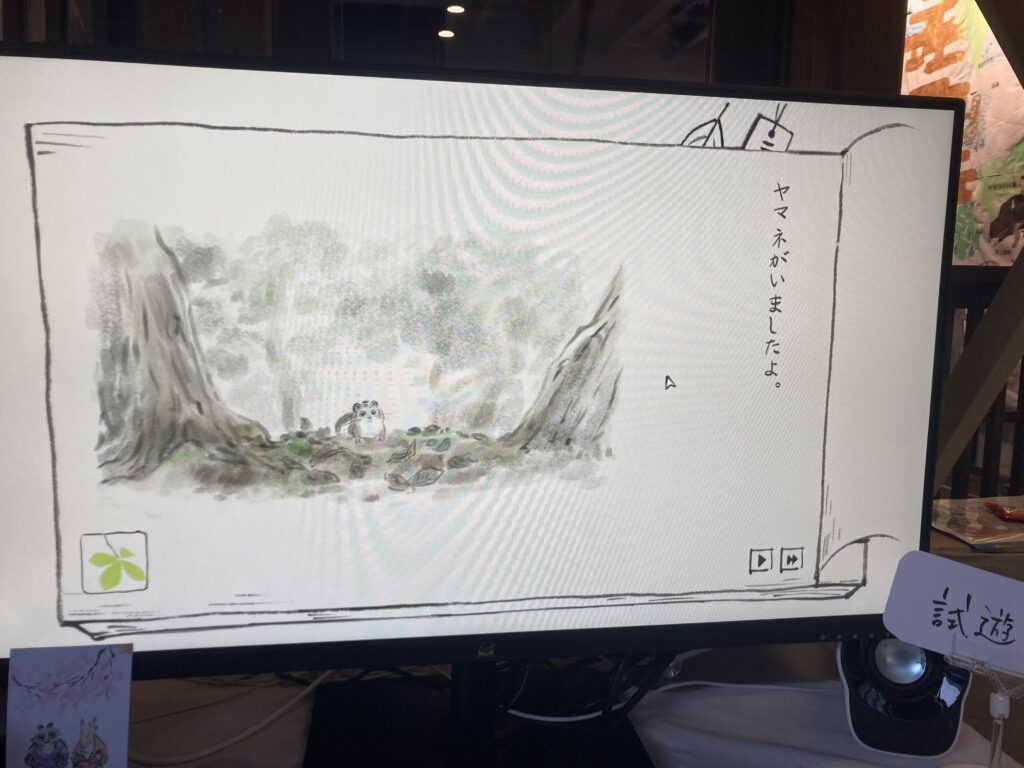
Why do such experiences linger in our hearts? It is not only the joy of immersing oneself in a well-crafted grand narrative, but also the opportunity to touch a world depicted from such a micro perspective, revealing how the creators perceive the nature and world around them. Perhaps it allows us to relive a part of that warm perspective. Honestly, the sensibilities and viewpoints we had in childhood, which we unknowingly lose over time, must be quite numerous. This game gently lifts up those forgotten feelings of joy in small discoveries, providing players with a truly grateful experience.
By the way, there is an interesting episode regarding how I came across this wonderful game. It all began with a postcard that was casually placed on a table in a corner of the same venue as ‘MeloMisterio’, called “Koetoko.” I was drawn to the beautiful illustration of a cherry blossom tree on the white paper, and when I casually picked it up, I found a cute four-panel comic on the back. The general introduction to the game was presented there, and I was amazed, thinking, “What a cute game this is,” and I ended up visiting the booth. I intend to keep this postcard especially safe from now on.
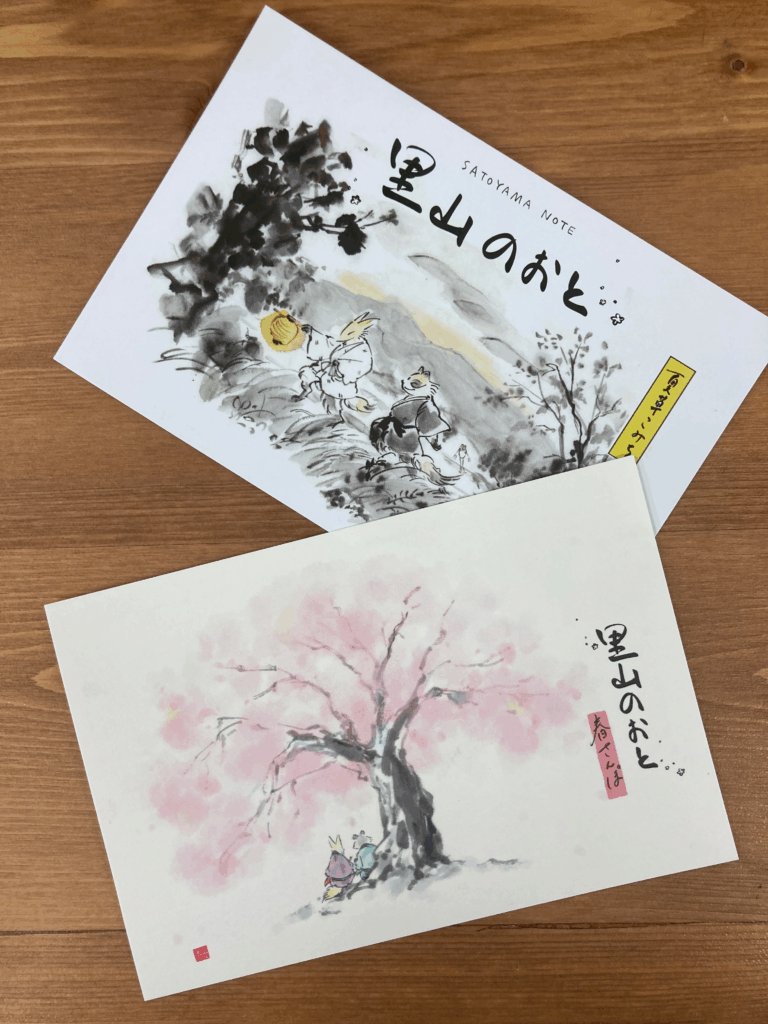
The one above seems to be from the previous work.
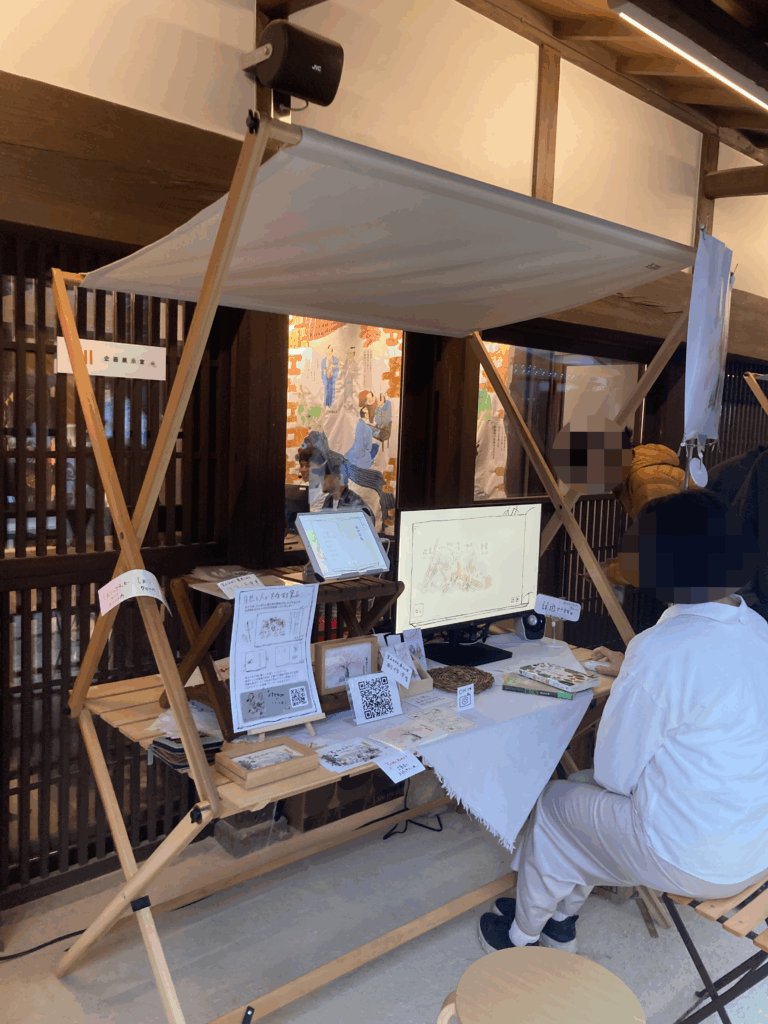
Like the postcard, the related merchandise was delicate and attractive. In particular, the designs of the bookmarks distributed at the booth were exceptional, and I couldn’t help but pick up all the varieties. By the way, it was indicated that these bookmarks could be obtained for a donation starting at 50 yen, but I felt that they were worth much more than that, so I took the liberty of paying 200 yen for four types, calculated at 50 yen each. …Up to that point, everything was fine, but I ended up making a huge mistake by forgetting my wallet at the booth. If the creator hadn’t remembered my face, I would have faced the tragedy of having to return to Kawagoe from Tokyo in that pouring rain to retrieve my wallet. Thank you so much for your help during that time…
Indie games often reflect the creator’s “likes” very strongly, but sometimes they also choose their players. In this work, I can feel a deep affection for plants and animals, and perhaps because the expression is unique and warm, it has an appeal that naturally attracts even those who are not usually familiar with it. It’s like when someone talks about their area of expertise with more joy and passion than anyone else; even if your interest in the theme itself is moderate, you can’t help but be drawn in by their enthusiasm and personality. This game provided a valuable experience that allowed me to reconnect with the “heart that appreciates the flowers and small creatures by the roadside,” which may have been sleeping within me for a long time.
PONKOTS: The Unpredictable “Ponkots” Creates the Ultimate Chaos and Cooperative Excitement
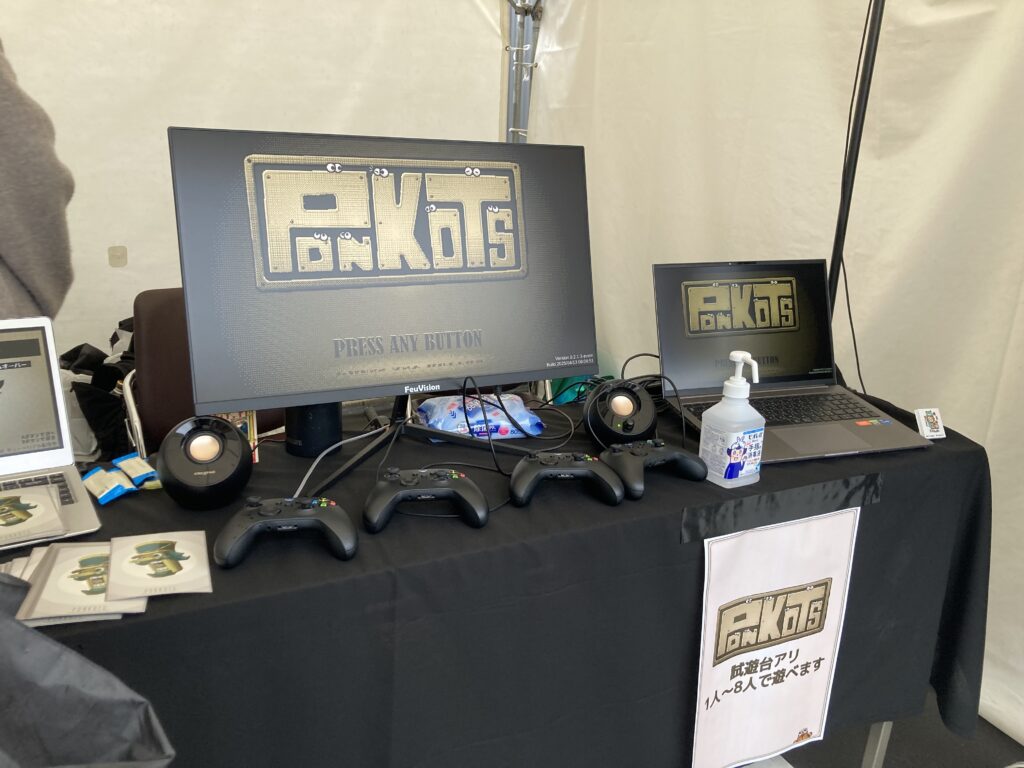
Now, the last game I will introduce in this report, and the one I personally found the most “interesting!” and played while shouting the loudest at this rainy Kawagoe GAME DIGG, is “PONKOTS.” Just from the name, you can sense that something extraordinary is about to happen.
The concept of this game is essentially about “supporting each other’s weaknesses.” It is a cooperative 2D casual action game that can be played by 3 to a maximum of 8 players. In this world, players control small toys, helping each other to escape and survive from the evil tin kings… Despite its cute appearance, there seems to be a story that conveys a sense of darkness. The basic rules are surprisingly simple: the main premise is to run away and avoid the projectiles (Houdan) that come flying towards the players.
However, there is a strong twist here. Every certain amount of time, one player randomly falls into a “ponkots” or incapacitated state. Other players must desperately push the incapacitated teammate out of the way to avoid the Houdan, and sometimes even act as a shield to protect them. In a situation that changes moment by moment, players’ quick judgment and teamwork are put to the test.
It might be hard to grasp just from the explanation, but the fun of this game is the kind that you can’t fully convey without experiencing it. However, in my experience, it was definitely the game I shouted the most during the event. Of course, this comes with the condition that it was okay to be a bit loud in a venue close to the outdoors where it was raining.

The requirement of at least three people was a bit of a hurdle, and as a solo participant, I was about to give up, but two of the creators kindly joined in, and an impromptu play session began. Despite being strangers, it felt like gathering at an old friend’s house to start playing Super Smash Bros, with a friendly atmosphere. After a brief game explanation, I found myself desperately controlling the toys. While the actual gameplay has many more elements, what’s certain is that it continuously creates a “chaos with no time to breathe,” with everyone exclaiming “Wow!” “It went that way!” “Help me!” in voices resembling screams, yet laughter never ceased, making it the best party game experience. Of course, the creators’ enthusiasm was also fantastic.
To illustrate this fun, I would say it feels like being in a constant situation where “the timer on a time bomb has one second left, and you have to cut the correct color wire, red or blue.” Everything, from becoming a “mess,” to cannonballs and gimmicks, is calculated for an unpredictable “chaotic feeling.” The retro 90s-style art, the metallic sound effects that clank, and the up-tempo BGM that heightens the sense of urgency all amplified the tension. The core of the experience lies in the exquisite use of “randomness.” With many elements determined randomly, players are constantly placed in a state of instability and uncertainty. They have no choice but to respond to unexpected threats on the fly. This “anxiety” fosters a sense of unity that one must cooperate, ultimately culminating in “hilarity.” After playing this game, I felt like I had touched one of the ideal forms of what truly entertaining cooperative games can create, thinking, “Ah, this is what a really fun cooperative game is all about.”
…I’ve passionately shared my thoughts, but here’s a somewhat personal and perhaps unconventional interpretation (this is my own interpretation). I felt that this game might, in a sense, serve as a “counter-thesis” in modern gaming. Nowadays, many games seem to focus on refined solo experiences and individual skill, but the cooperation in ‘PONKOTS’ is much more primitive. It emphasizes mutual aid, where those around literally put their bodies on the line to help a “messy” teammate. It values the sense of unity in the “scene” over individual proficiency, and the incidental joy of being “together”—that original scenery of making noise at a friend’s house—might be the core of this work.
The treatment of “randomness” is similar. In many games, randomness is often used as a “convenient all-purpose seasoning,” but in PONKOTS, it is different. Instead of helping the player, it functions as a “fluctuation” that threatens and creates a sense of urgency that forces cooperation with chaos. That’s why you find yourself laughing while screaming. It might be very close to that feeling from childhood when all your friends were on a trampoline, unable to stand properly on the unstable surface, yet somehow everyone was laughing together.
I couldn’t have a deep conversation with the creator, but more than anything, I want to express my heartfelt gratitude for their enthusiasm and for enjoying the game with me, a complete stranger. Normally, trying out a game designed for cooperative play alone can be a high hurdle both physically and psychologically, but with PONKOTS, the feeling of “I absolutely want to play this game with someone!” surged strongly after playing. This is a feeling I haven’t had in a long time. Although it’s still in development, it made me think, “I need to make sure I have friends to laugh and roll around with before this game is released.” It was a wonderful encounter with an amazing work that instilled a strange determination (?) and anticipation for the future.
Rainy Kawagoe, a Once-in-a-Lifetime Encounter with Games
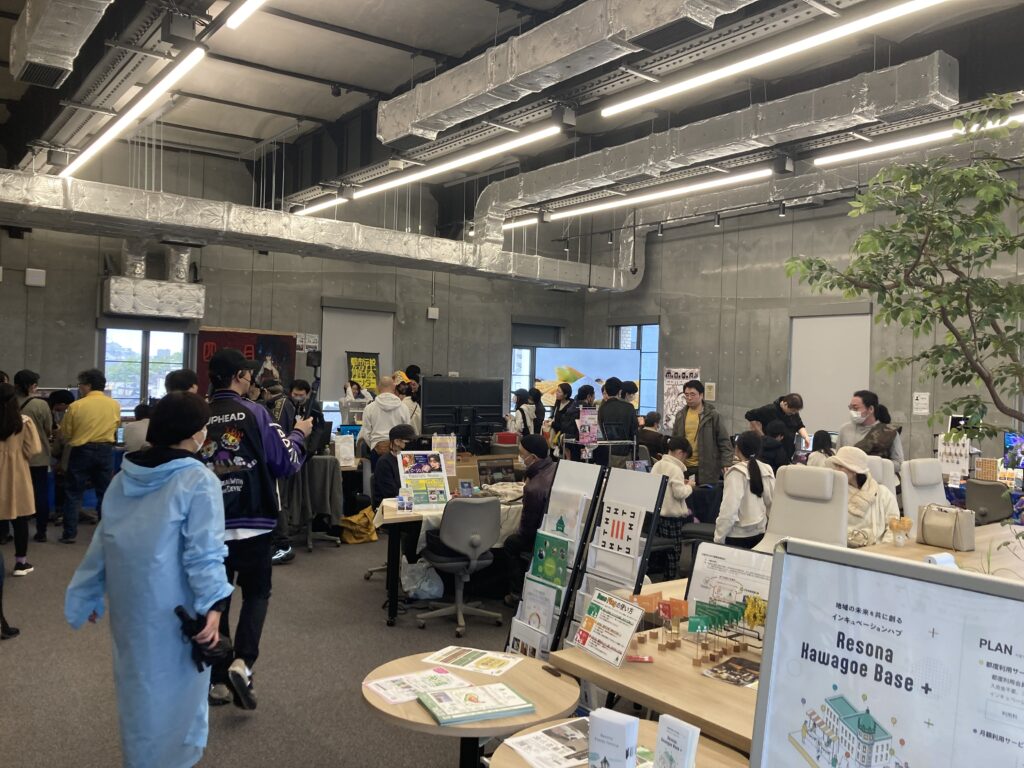
Now, I have talked about four unique indie games that captivated my heart at the Kawagoe GAME DIGG held in the rain: Yugiri Ninja, MeloMisterio -play your melody-, Satoyama no Oto: Haru Sanpo, and PONKOTS. Each of them might have left a slightly different impression if it weren’t for the weather that day and that location… It truly felt like a meeting worthy of being called a once-in-a-lifetime encounter.
To be honest, the concept of “open town type,” which was supposed to be a major feature of the event, might have been difficult to fully experience due to the continuous rain. There were certainly parts of the ideal enjoyment I had envisioned, wandering through the historic streets of Kawagoe with a pamphlet in hand, visiting the scattered booths, that did not come to fruition.
However, if asked whether the experiences at this event were meaningless, the answer is definitely “no.” Yugiri Ninja taught me about the enthusiasm of the local community and the potential for new interactions through games. MeloMisterio resonated with a strange auditory experience that merges the real space of historical buildings with digital art. Satoyama no Oto gently reminded me of the small adventures lurking right next to our daily lives and the gentle perspectives I had almost forgotten. And PONKOTS slammed down the primal excitement of cooperative play and the best chaos filled with endless laughter.

Each of these intense gaming experiences, even in the face of adverse weather, or rather, precisely because of such circumstances, may have shone even brighter and been etched deeply and vividly in my memory. The sincere efforts of the developers at each booth, who passionately connected with us while shaping their “likes” and “things they wanted to create” despite the rain, undoubtedly supported that brilliance. After all, I realized once again that no matter the situation, interesting games and emotionally moving games never lose their essential charm.
This time at Kawagoe GAME DIGG was a highly stimulating and educational day that made me reconsider “What is indie gaming?” and “What is the significance of offline events?” from various angles. I feel I gained many insights and discoveries not only from the perspective of a mere gamer but also as a developer creating the same games, and as an individual living daily life. In particular, the sensation I felt through my encounter with ‘Yugiri Ninja,’ where my rigid preconceptions felt like they were “drained,” seems likely to positively influence my future game development and my approach to indie games.
Now, with many stimulating encounters and a few personal assignments in mind, I think it’s time to put down my pen for this report. I’m sure there are still many unknown charms sleeping in the city of Kawagoe, which I couldn’t fully enjoy in the rain. If I have the opportunity to visit this place again, I would love to leisurely explore the city under a clear sky.
The world of indie games is surely continuing to create new surprises and emotions somewhere in the world at this very moment. With excitement in my heart about what wonderful encounters await next, I will wrap up for now as it’s time to go.
By the way, how is the progress of our SKOOTAGAMES, Negolove team? Well, let me talk about that on another occasion.
Well then, see you in the next report!
